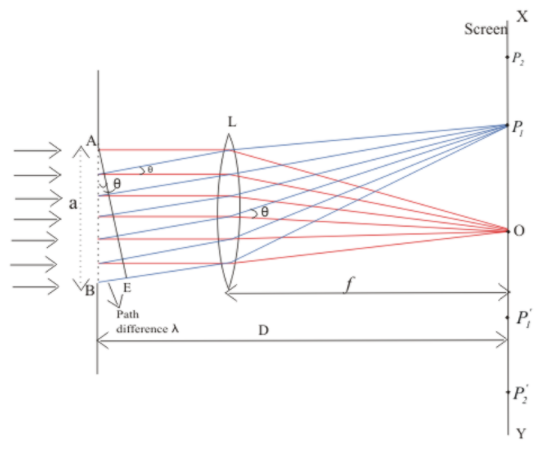
Answer
461.7k+ views
Hint: When light passes through a single slit whose width ‘w’ is on the order of the wavelength of the light, then we can observe a single slit diffraction pattern on a screen that is a distance L away from the slit.
Complete answer:
Single slit diffraction is observed when light passes through a single slit whose width is in the order of the wavelength of the light. Diffraction of light is defined as the bending of the light around the corners such that it spreads out and illuminates areas where a shadow is expected. Since, diffraction and interference both occur simultaneously it is hard to separate them.

Let us assume that a parallel beam of light incident on a slit AB of width ‘a’ which is of order f the wavelength of light as shown in the figure. A real image of diffraction pattern is formed on the screen with the help of converging lenses placed in the path of the diffracted beam. All the rays which start from the slit AB in the same phase and produce brightness at point O on the axis of slit as they arrive in the same phase. Thus, the diffraction pattern on screen consists of a central bright band and alternate dark and bright bands of decreasing intensity on both sides.

Hence, the above figure is the required graphical representation of variation of the intensity distribution with their distance from the centre of the central maxima.
Note:
Intensity of these secondary maxima is much less than central maxima and falls off as rapidly as it moves outwards. The central maxima lies between the minima and the width of the central maximum is the distance between the first order minima from the centre of the screen on both the sides of the centre.
Complete answer:
Single slit diffraction is observed when light passes through a single slit whose width is in the order of the wavelength of the light. Diffraction of light is defined as the bending of the light around the corners such that it spreads out and illuminates areas where a shadow is expected. Since, diffraction and interference both occur simultaneously it is hard to separate them.

Let us assume that a parallel beam of light incident on a slit AB of width ‘a’ which is of order f the wavelength of light as shown in the figure. A real image of diffraction pattern is formed on the screen with the help of converging lenses placed in the path of the diffracted beam. All the rays which start from the slit AB in the same phase and produce brightness at point O on the axis of slit as they arrive in the same phase. Thus, the diffraction pattern on screen consists of a central bright band and alternate dark and bright bands of decreasing intensity on both sides.

Hence, the above figure is the required graphical representation of variation of the intensity distribution with their distance from the centre of the central maxima.
Note:
Intensity of these secondary maxima is much less than central maxima and falls off as rapidly as it moves outwards. The central maxima lies between the minima and the width of the central maximum is the distance between the first order minima from the centre of the screen on both the sides of the centre.
Recently Updated Pages
Write the IUPAC name of the given compound class 11 chemistry CBSE

Write the IUPAC name of the given compound class 11 chemistry CBSE

Write the IUPAC name of the given compound class 11 chemistry CBSE

Write the IUPAC name of the given compound class 11 chemistry CBSE

Write the IUPAC name of the given compound class 11 chemistry CBSE

Write the IUPAC name of the given compound class 11 chemistry CBSE

Trending doubts
Fill the blanks with the suitable prepositions 1 The class 9 english CBSE

How do you graph the function fx 4x class 9 maths CBSE

Which are the Top 10 Largest Countries of the World?

Which is the longest day and shortest night in the class 11 sst CBSE

What is the definite integral of zero a constant b class 12 maths CBSE

Name five important trees found in the tropical evergreen class 10 social studies CBSE

The Equation xxx + 2 is Satisfied when x is Equal to Class 10 Maths

Differentiate between homogeneous and heterogeneous class 12 chemistry CBSE

Difference between Prokaryotic cell and Eukaryotic class 11 biology CBSE




